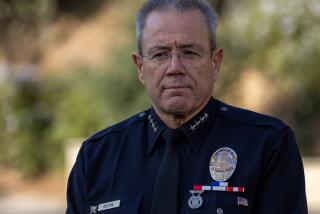Australian woman shot by cop ‘did not have to die,’ Minneapolis police chief says

- Share via
Reporting from MINNEAPOLIS — An Australian woman should not have been shot to death by a Minneapolis police officer responding to her 911 call, and the officer’s actions “go against who we are in the department,” the city’s police chief said.
In her first public remarks on the killing, Chief Janee Harteau on Thursday defended Officer Mohamed Noor’s training but lamented the death of 40-year-old bride-to-be Justine Damond, who was shot in the stomach as she approached a squad car near her home.
“This did not have to happen. Justine did not have to die,” Harteau said.
Damond had called 911 twice late Saturday to report a possible sexual assault in the alley behind her house on Minneapolis’ southwest side. Noor, who was in the passenger seat of a squad car, shot at Damond through the driver’s side window.
“The actions in question go against who we are in the department, how we train and the expectations we have for our officers,” Harteau said. “These were the actions and judgment of one individual.”
Noor has declined to speak with the state’s Bureau of Criminal Apprehension, which is handling the investigation. His partner, Matthew Harrity, told investigators he was startled by a loud sound right before Damond approached the police vehicle.
Neither officer had their body cameras on, which has drawn widespread criticism. Mayor Betsy Hodges said in a blog post Thursday that officers should turn them on any time they are responding to a call.
Harteau also said the cameras should have been on. She said the department is making changes to its policy on the body cameras, rolled out citywide eight months ago, including looking at technology that would turn them on automatically.
Damond’s family members have said they want changes in police protocols, including a look at how often officers are required to turn on their cameras. Their Minneapolis attorney, Bob Bennett, said they also “want to see this person not be an officer.”
“He shouldn’t be on the street with a gun making decisions,” Bennett said, adding that he wanted to see Noor’s training records, including how he did in situations involving when to shoot or not shoot.
Harteau said a report on Noor’s training showed no problems.
“This officer completed that training very well,” she said. “He was very suited to be on the street.”
Meanwhile, hundreds of people joined a march in Minneapolis Thursday evening to honor Damond’s life.
Among those gathered to mourn Damond was Valerie Castile, whose son Philando Castile was shot to death by a suburban police officer during a traffic stop in July 2016.
Demonstrators paused outside Damond’s home, where Castile hugged Damond’s fiance, Don Damond. Mourners dropped off flowers and handwritten notes in the alley where Damond was shot.
The Damond family is the latest to seek changes in police practices following a shooting.
Other police shootings around the U.S. — particularly the killings of black men by officers — led to calls for change that included everything from bias training for officers to upgraded technology. Sometimes those changes have been initiated by police departments. Other times they have been ordered by the federal government or through a lawsuit.
Minneapolis police said earlier this week they already were reviewing their body camera policy before Damond’s death. Issues being examined include having supervisors work with patrol officers to ensure the cameras are activated more frequently.
Minnesota created a $12-million police training fund after the shootings of Castile, the black motorist killed last year in suburban Minneapolis, and Jamar Clark, a black man killed in 2015 in Minneapolis. The Legislature also approved $35 million in programs meant to reduce long-standing economic disparities between black and white residents, which Black Lives Matter and other organizations targeted as a root problem behind tension with police.
In Castile’s case, Minnesota’s governor and family members called for a federal investigation, and residents called for changes during city meetings. In the end, there was no federal civil rights investigation into Jeronimo Yanez, the St. Anthony, Minn., officer who fatally shot Castile, but the city of St. Anthony requested a voluntary review by the U.S. Department of Justice’s Office of Community Oriented Policing Services. That review is looking at traffic stops, recruitment practices and how the department works with the community.
In Cleveland, the death of Tamir Rice helped spur a Justice Department investigation and consent decree that led to a revised use-of-force policy. The black 12-year-old was playing outside with a replica gun that shoots nonlethal plastic pellets when a white officer shot him in 2014.
The revised policy requires officers to try de-escalation techniques, such as taking cover, to avoid using force.
The department’s previous policy allowed officers to use force, including firearms, if they determined it was “objectively reasonable,” meaning it’s something an average officer would do. The new policy says force must be necessary and “proportional” to the threat.
In Milwaukee, the Justice Department’s COPS program in 2015 laid out the broad strokes of a plan for the police force as part of a voluntary review that’s still underway. That followed the death of Dontre Hamilton, a mentally ill black man who had been sleeping in a downtown park when an officer shot him 14 times in 2014. The review is looking at police use of force, racial disparities, community engagement and mass demonstrations.
The COPS program also has agreed to review the policies of North Charleston, S.C., after the 2015 fatal shooting of Walter Scott. The review will examine how the department could improve its relationship with residents and its policing strategies.
ALSO
Atty. Gen. Jeff Sessions revives controversial practice of police seizing suspects’ assets
Body camera video shows police trying to explain why they pulled over Florida state attorney
More to Read
Sign up for Essential California
The most important California stories and recommendations in your inbox every morning.
You may occasionally receive promotional content from the Los Angeles Times.










